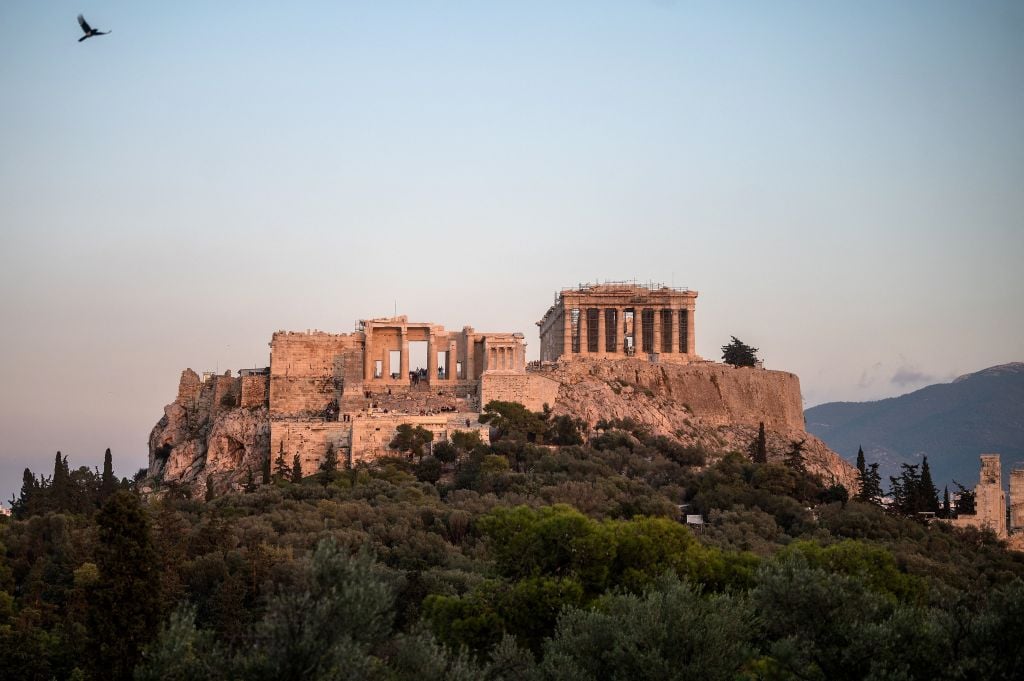
The hills around Vari, 10 miles southeast of Athens, are etched with the musings of bored shepherds. The more than 2,000 graffiti (and counting) feature trireme warships, speeding horses, packs of hunting dogs, and the odd erotic scene.
Dating from the sixth century B.C.E., the graffiti have been the subject of considerable academic research over the past two decades, shedding light on the customs, worldview, and literacy rates of common citizens. Most recently, a tiny graffito carved into a marble outcrop seems to show the presence of a lost temple on the site of the Parthenon, Athens’s holy rock.
Discovered on a dirt track leading from the coastal highway to a hilltop communication tower, the graffito comprises a view of the façade of a building with five columns and approaching steps. Like all good graffiti artists, the likely shepherd has tagged his name: Mikon. A second word that snakes around the image of the temple is Hekatompedon, meaning “100-footer,” which appears to reference a temple of enormous size and cultural significance.
Sketch of the graffito, indicating reasonably secure lines and letters. Photo: courtesy Archaeological Institute of America and the American Journal of Archaeology.
The graffiti is the subject of an article in the American Journal of Archaeology by Merle Langdon and Janric van Rookhuijzen in which the authors suggest it points to a temple located on the south side of the Acropolis that preceded the Parthenon.
“The Hekatompedon, which had perhaps recently emerged from Athena’s holy rock, was a natural source of Mikon’s awe,” the authors wrote. “His drawing now stands as the earliest known testimony of admiration of the architecture of the Acropolis—and as the first of many to come.”
The location of the graffiti in the landscape, roughly 10 miles outside of Athens. Photo: Archaeological Institute of America and the American Journal of Archaeology.
The researchers were able to date the graffito to the second half of the sixth century B.C.E based on the use of the Old Attic alphabet. This infers that Mikon’s temple is at least 50 years older than the Parthenon.
The iconic temple that today overlooks Athens was built in the wake of the Greek-Persian wars that involved the Persians sacking all the buildings on top of the Acropolis in 480 B.C.E.
The graffiti on the side of a marble outcrop. Photo: Archaeological Institute of America and the American Journal of Archaeology.
The presence of a Hekatompedon predating the Parthenon is not in question. In fact, the entire hill was once referred to by the term Hekatompedon and a democratic decree from 485 B.C.E. mentions the presence of one such building on the Acropolis. Academics, however, have long debated precisely what function this Hekatompedon served. The decree simply states it was used for “treasure storage”; some argue this is in keeping with the regular role of a temple, while others contend it instead implies a large courtyard on the Acropolis.
Mikon’s drawing together with the use of Hekatompedon as a definite article appears to evidence an earlier superstructure.
“The engraving can inform future studies of the architectural history of the Acropolis,” the authors wrote. “It strengthens the view that this term referred to a temple, with a probable, though uncertain, location on the south side of the Archaic-period Acropolis.”